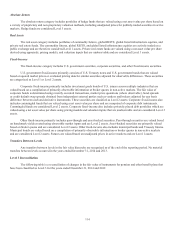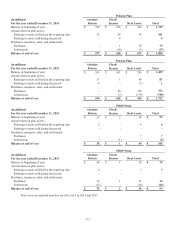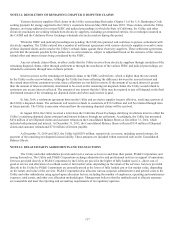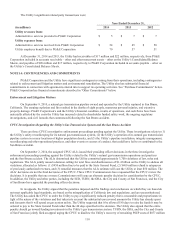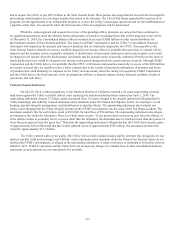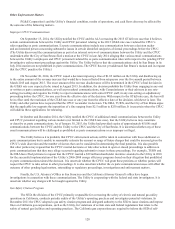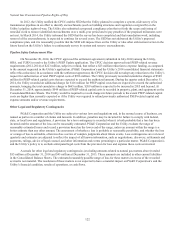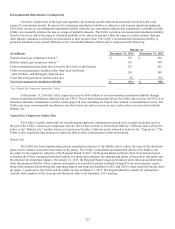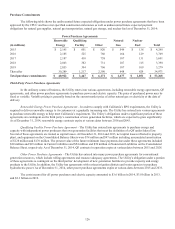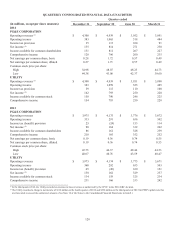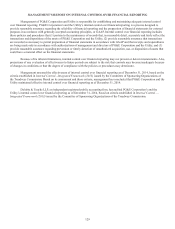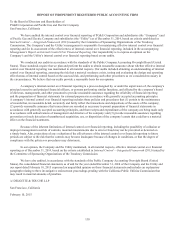PG&E 2014 Annual Report Download - page 130
Download and view the complete annual report
Please find page 130 of the 2014 PG&E annual report below. You can navigate through the pages in the report by either clicking on the pages listed below, or by using the keyword search tool below to find specific information within the annual report.122
Natural Gas Transmission Pipeline Rights-of-Way
In 2012, the Utility notified the CPUC and the SED that the Utility planned to complete a system-wide survey of its
transmission pipelines in an effort to identify encroachments (such as building structures and vegetation overgrowth) on the
Utility’s pipeline rights-of-way. The Utility also submitted a proposed compliance plan that set forth the scope and timing of
remedial work to remove identified encroachments over a multi-year period and to pay penalties if the proposed milestones were
not met. In March 2014, the Utility informed the SED that the survey has been completed and that remediation work, including
removal of the encroachments, is expected to continue for several years. The SED has not addressed the Utility’s proposed
compliance plan, and it is reasonably possible that the SED will impose fines on the Utility or take other enforcement action in the
future based on the Utility’s failure to continuously survey its system and remove encroachments.
Pipeline Safety Enhancement Plan
On November 20, 2014, the CPUC approved the settlement agreement (submitted in July 2014) among the Utility,
ORA, and TURN to resolve the Utility’s PSEP Update application. The CPUC decision approved total PSEP-related revenue
requirements (2012-2014) of $223 million, subject to refund, that reflect a $23 million reduction to expense funding, as compared
to the amount requested in the Utility’s application. (PG&E Corporation’s and the Utility’s 2014 consolidated financial statements
reflect this reduction.) In accordance with the settlement agreement, the CPUC decision did not adopt any reduction to the Utility’s
request for authorization of total PSEP capital costs of $766 million. The Utility previously recorded cumulative charges of $549
million for PSEP-related capital costs that are expected to exceed the authorized amount. During the quarter ended December 31,
2014, the Utility recorded an additional charge for $116 million for PSEP capital costs that are expected to exceed the authorized
amounts, bringing the total cumulative charge to $665 million. $209 million is expected to be incurred in 2015 and beyond. At
December 31, 2014, approximately $549 million of PSEP-related capital costs is recorded in property, plant, and equipment on the
Consolidated Balance Sheets. The Utility would be required to record charges in future periods to the extent PSEP-related capital
costs are higher than currently expected or if the Utility was required to refund previously authorized PSEP-related capital and
expense amounts and/or revenue requirements.
Other Legal and Regulatory Contingencies
PG&E Corporation and the Utility are subject to various laws and regulations and, in the normal course of business, are
named as parties in a number of claims and lawsuits. In addition, penalties may be incurred for failure to comply with federal,
state, or local laws and regulations. A provision for a loss contingency is recorded when it is both probable that a loss has been
incurred and the amount of the loss can be reasonably estimated. PG&E Corporation and the Utility evaluate the range of
reasonably estimated losses and record a provision based on the lower end of the range, unless an amount within the range is a
better estimate than any other amount. The assessment of whether a loss is probable or reasonable possibility, and whether the loss
or a range of loss is estimable, often involves a series of complex judgments about future events. Loss contingencies are reviewed
quarterly and estimates are adjusted to reflect the impact of all known information, such as negotiations, discovery, settlements and
payments, rulings, advice of legal counsel, and other information and events pertaining to a particular matter. PG&E Corporation’s
and the Utility’s policy is to exclude anticipated legal costs from the provision for loss and expense these costs as incurred.
Accruals for other legal and regulatory contingencies (excluding amounts related to natural gas matters above) totaled
$55 million at December 31, 2014 and $43 million at December 31, 2013. These amounts are included in other current liabilities
in the Consolidated Balance Sheets. The estimated reasonably possible range of loss for these matters in excess of the recorded
accrual is not material. The resolution of these matters is not expected to have a material impact on PG&E Corporation’s and the
Utility’s financial condition, results of operations, or cash flows.




